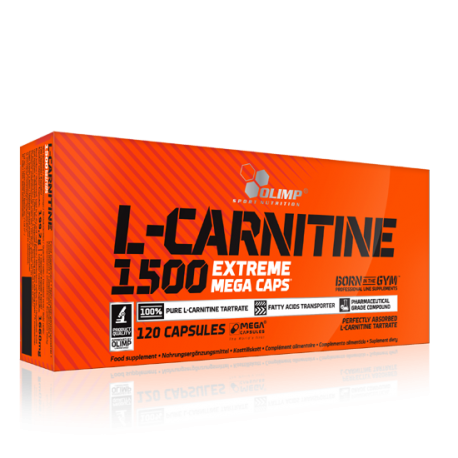L-carnitine tartrate
Filters
-
 Save 0%
Save %
Original price €44,90 - Original price €44,90Original price €44,90€44,90€44,90 - €44,90Current price €44,90| /
Save 0%
Save %
Original price €44,90 - Original price €44,90Original price €44,90€44,90€44,90 - €44,90Current price €44,90| /AllDayYouMay · 435g
5% Nutrition11 reviewsBCAAs with a 10:1:1 ratio Support for joints & liver Powerful antioxidant immune system support Muscle endurance booster Faster recovery Fast...
View full detailsOriginal price €44,90 - Original price €44,90Original price €44,90€44,90€44,90 - €44,90Current price €44,90| /Save 0% Save % -
 Save 0%
Save %
Original price €36,90 - Original price €36,90Original price €36,90€36,90€36,90 - €36,90Current price €36,90| /
Save 0%
Save %
Original price €36,90 - Original price €36,90Original price €36,90€36,90€36,90 - €36,90Current price €36,90| /L-Carnitine 1500 Extreme Mega Caps · 120 capsules
Olimp Sport Nutrition3 reviewsL-Carnitine transports fatty acids for oxidation in the mitochondria Olimp L-Carnitine 1500 Extreme Mega Caps is a dietary supplement with a high ...
View full detailsOriginal price €36,90 - Original price €36,90Original price €36,90€36,90€36,90 - €36,90Current price €36,90| /Save 0% Save %
Carnitine is formed by the body from the amino acids lysine and methionine and is therefore not considered essential. The L-form is physiologically important. Carnitine has important functions in the body Carnitine is needed to release energy from fats. It transports fatty acids into the mitochondria, the "power plants" of the cells. Carnitine contributes in particular to supplying the heart with oxygen and is generally important for good heart function.
Please also read the report on carnitine
Studies on carnitine tartrate
The aim of this study was to test the bioavailability of 6 different L-carnitine compounds. For this purpose, the intake of L-carnitine USP was compared with that of acetyl-L-carnitine, lauroyl-L-carnitine, L-carnitine tartrate, L-carnitine fumarate and L-carnitine citrate in 38 male piglets, which were available as model animals. In our own studies, a single oral L-carnitine dose of 40 mg/kg body weight or 248 µmol/kg body weight was administered. The L-carnitine compounds were evaluated by analyzing blood plasma, erythrocytes, urine and faeces. Due to the lack of comparative data from the literature and the current state of knowledge about L-carnitine, the interpretation of the available data is difficult. In principle, differences between the various L-carnitine compounds are recognizable with regard to absorption, uptake into the erythrocytes and excretion via the urine. Numerous studies (GREIG et al, 1987; FOSTER et al, 1988; SOOP et al, 1988; FOSTER and HARRIS, 1989; FOSTER et al, 1989; BÖHLES et al, 1991; LI et al, 1992; FÖHRENBACH et al, 1993) have shown that the concentration of L-carnitine in plasma increases in various species after oral intake. In the present study, both the FC and GC concentrations in plasma increased on average by 2.2 and 2-fold, respectively, in the animals of all test groups just 1 h after oral L-carnitine administration. The absorption of L-carnitine in humans is characterized by slow mucosal uptake, prolonged mucosal retention and slow mucosal entry into the blood (GROSS et al., 1984; GUDJONSSON et al., 1985 a, b). However, no quantitative data on time or speed are given. The work of REBOUCHE (1991) provides an explanation for this. He found the maximum concentrations in the serum only 2-4.5 h after oral supplementation of radioactively labeled [methyl-3H]L-carnitine. He saw the reason for this in the relatively slow absorption of L-carnitine from the intestinal lumen. BACH et al. (1983), LI et al. (1992) and RIZZA et al. (1992) also investigated the influence of different oral L-carnitine doses - also in humans. They were able to show that the maximum concentration of L-carnitine in the plasma (3.5 h after supplementation) is dependent on the respective L-carnitine dose (30 mg/kg, 100 mg/kg and 2 g/day). In the literature, the time course of the concentration of L-carnitine in plasma after a single dose is often used as a guide to estimate the absorption of the respective L-carnitine compound. In order to characterize the rate of absorption in more detail, the time points of the maximum concentrations of L-carnitine in the plasma are determined. The change in the concentration of L-carnitine in the plasma does not necessarily indicate the absorption capacity, as L-carnitine can be subject to a "first-pass" effect. In this case, L-carnitine could be absorbed in relatively large quantities; however, a high "first pass" effect, for example of the liver (transport via the portal vein to the liver and only then into the venous system) would result in the absorbed L-carnitine being broken down quickly and thus less reaching the venous system from which the blood samples were taken. During liver passage, the L-carnitine content can be significantly reduced by metabolization and biliary excretion. The composition of portal vein blood can therefore not be equated a priori with that of peripheral blood in the systemic circulation. There is a "portal-peripheral difference". Only the portion that reaches the systemic blood is bioavailable and can be captured in the venous system. The relatively large time intervals at which the plasma samples were obtained must be taken into account in this work as a limiting factor for the accuracy of the results. For technical reasons, however, it was not possible to take the blood samples at shorter intervals. The true maximum L-carnitine concentrations in plasma cannot necessarily be assigned to the measured maximum. More likely is a point in time in the interval defined by the two measured values before and after the maximum value. The maxima determined for the FC and GC in the plasma were between 3.5 h (L-carnitine tartrate) and 7 h (L-carnitine USP, L-carnitine fumarate, acetyl-L-carnitine, L-carnitine citrate and lauroyl-L-carnitine) after supplementation. Obviously, L-carnitine tartrate is absorbed faster than the other L-carnitine compounds. This can be clearly seen in the figure: The increase in concentration at the beginning of the test period is clearly greatest for L-carnitine tartrate. In addition, the maximum value is reached the fastest. This also shows the highest absolute values. For reasons of clarity, not all progression curves were shown in one figure. Apparently, the L-carnitine esters (see Fig. , right-hand diagram) are less well absorbed than the other L-carnitine compounds, at least their maximum values are significantly lower than those of the other compounds.
L-carnitine tartrate steroid-like benefits?
According to scientists, carnitine tartrate supplementation may have another unexpected benefit. One study examined the effect of carnitine on testosterone response and androgen receptors after heavy weight training followed by a carbohydrate-protein meal. The ten male participants with an average age of 21 years took either a placebo or two grams of carnitine tartrate per day for 21 days. The baseline number of androgen receptors was higher in the carnitine group. After the post-workout meal, the amount of testosterone in the blood plasma decreased and was lower in the carnitine group. It appears that carnitine causes an increase in androgen receptors at rest. Less testosterone was measured in blood plasma because it interacts with numerous androgenic receptors. Anabolic steroids and training increase the number of androgenic receptors.
Dosage
2-4 grams of L-carnitine tartrate daily ensure more productive training and more effective recovery. Take 2 grams before and 2 grams after training.


